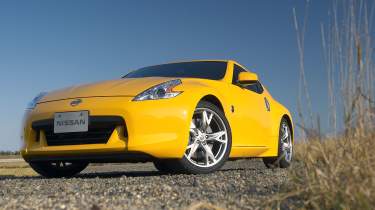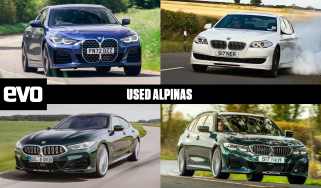Nissan 370Z
Sharper and more powerful, Nissan’s new 370Z gains the edge
Koblenz. The sign clearly says Koblenz. My geography isn’t great (despite being quite handy at colouring in), but the last time I looked, Koblenz was in Germany. And yet I’m pretty sure I woke up at 2am this morning with terrible jet lag on North Island, Japan. Odd. We’re driving on the right, yet the box-shaped vehicle we’re in is right-hand drive. Those trees look awfully German too. My head’s starting to hurt.
Wherever I am, I’m one of four UK journalists who are about to drive the new Nissan 370Z. It’s late October and the car is still very much under wraps, but our quartet has just had the full press presentation and I’m now very excited about the new Zed. Shorter, wider, stiffer and with more power, it should be an absolute cracker. Nothing less than beating the Porsche Cayman will do for Nissan…
The 370Z, as its name suggests, now has a 3.7-litre V6, which produces 326bhp at 7000rpm and 269lb ft at 5200rpm (the 350Z had 309bhp and 264lb ft). The overall length of the car is 65mm shorter, while the wheelbase has been reduced by 100mm; the engine is also mounted slightly lower than before and the driver sits some 15mm closer to the ground. The engineer giving the PowerPoint chit-chat also seemed very proud of the fact that they have reduced the weight of the new 370Z by 110kg. Except they haven’t. In the process of improving the car, meeting safety regulations, etc, the engineers ended up increasing weight by 110kg, but they then managed to strip the same weight back out again by making the doors, bonnet and boot out of aluminium. So after all that, the 370Z weighs exactly the same as the 350Z – just over 1500kg.
More reviews
The wheels and brakes come in two different packages. The basic set-up is 18in cast alloys with floating calipers on the brakes, but the S and ST models – which we’ll be driving today – get 19in forged alloys hiding 355mm discs at the front clamped by four-piston fixed calipers. The suspension retains a multi-link set-up at the rear, but the front has now been switched to double wishbones.
The six-speed manual gearbox remains the default choice for the Zed, although it now comes with something called Synchro Rev Control, of which more later. We never got the automatic 350Z in the UK (and I don’t think we were missing out on much), but the 370Z will be coming to us with the option of a new seven-speed auto complete with paddle-shift.
Once the press conference had ended we were ushered into the two right-hand-drive boxes on wheels, which turned out to be Nissan Serenas. We are – in case you hadn’t guessed – at Nissan’s Hokkaido Rikubetsu proving ground. It was built around 20 years ago and is the only one of Nissan’s four (four!) proving grounds to feature a ‘country course’, a high-speed circuit with no banked sections (completed only a couple of years ago) and a cold-climate test track. Although there’s no snow around at the moment, it is noticeably colder up on Japan’s North Island compared with Tokyo, where we flew in a couple of days ago. It’s a sort of dry chill that speaks of high altitude.
As we trundle over a bridge onto the infield of the high-speed track, everything changes from Japanese to German. We really could be in the Eiffel Mountains and approaching the Nürburgring. Apparently even the conifers were specially imported to match those found in western Germany. Quite what improvement this arboreal transplant has had on the development of the 370Z I don’t know, but the effect is striking. Surrounded by the deciduous sea of autumnal colours that makes up the Japanese countryside, the proving ground must look like a dark green pool of evergreen Germanity if you’re flying over it.
As we turn off the wide access road onto a smaller tributary, a yellow sign points towards Tiergarten. We approach a small sort of congregational area, complete with marquee and a trio of 350Zs that we drive first to aid comparison with the new and hopefully improved model. The 350 is in many ways the antithesis of its bigger brother the GT-R. It is quite an old-fashioned car, complete with a resolutely hefty manual gearchange, rear-wheel drive, not a sniff of charged air near the engine, and electronics that don’t stretch much further than an ESP button. It is, however, a wonderful formula that allows a driver myriad options in a corner, and it’s been one of our favourite cars for the last five years.
We’ll get just three stabs at a ten-minute test route around the proving ground in the 370. Each time around we’ll take in the twisting country road, followed by a lap of the high-speed autobahn loop. The country road is a two-lane affair, starting open and flowing, before getting tighter with some good second- and third-gear corners. The tarmac then dives into a more enclosed section with Armco worryingly close. Here there are some technical corners with bumps viciously inserted into apices, and tightening radiuses added to make both you and the car feel a bit unsettled. It dips and crests in a very Nordschleife sort of way too.
The high-speed section is not quite as exciting as it sounds because these cars all have the Japanese Domestic Market limiters on them. As a result, you feel an invisible forcefield grip the car at about 112mph, after which you can simply sit back and enjoy the view and the various and varied surfaces that have been set into the inside lane.
It gets dark early here so I’m rushed politely and with urgently inviting bows into the 370Z for the first time. It has a semi-keyless system so you simply need to have the fob about your person and then press the starter button, after which the car starts with a slightly deeper, more guttural sound than the 350. The clutch still requires a little finesse off the line and the gearbox still has that chunky weight to the stubby lever. Up the hill for the first time and a slightly surprising absence of low-down torque remains, although the V6 spins more easily through the lower register and up to the top end where it does its best work. It’ll be interesting to see if it can match the very bold 4.4sec to 60mph claim…
The biggest changes are clearly in the chassis, though. From the very first corner the steering is noticeably more accurate and precise. Torsional stiffness has been significantly improved and it feels like it, with the nose turning more immediately and the shorter wheelbase carving a line through the corner more acutely. In the 350 there was a slight delay between the moment you turned the wheel and when the tyres reacted; in the 370 there is much more immediacy. In fact the whole car feels laterally stiffer – where previously loading-up the 350Z’s chassis in a corner felt like leaning against a softly padded wall, it feels like you come up against resistance from the 370’s Bridgestones much more quickly.
The downside to all this improved responsiveness and added rigidity is a ride that has become noticeably firmer. It’s still well damped, but there is more road-noise and chatter coming up into the cabin. It doesn’t upset how the 370Z performs and I’m pretty sure it won’t be fazed on a Welsh B-road, but I do wonder if the added harshness might put off a few less committed customers who are looking to use the car on a day-to-day basis.
As I get back to our temporary car park for the first time, however, I’m in no doubt that the 370Z is more focused as a drivers’ car, and that is good news. You can make up your own mind about how it looks, but walking around the selection of cars whilst others are out driving, I come to the conclusion that the brighter colours look best, and happen to think that it looks better in motion than at rest. I also love the ‘Z’ indicator repeaters on the front wings and the way the outline of the side windows resembles that seen on the GT-R.
Lift up the rear hatch and you’ll notice that the large strut that used to brace across the rear axle line of the 350Z has moved to directly behind the seat-backs, thereby freeing-up a veritable cavern of luggage space. The seats themselves are identical to those in the old car, but now have sueded sections to them, which help to stop you sliding around when you’re sliding around (if you see what I mean). The steering wheel still has a nicely slim rim, but the spokes have now been slimmed to match, and it feels more in keeping with a sports car. The dials behind it are bigger than before, with the focus very much on the large rev-counter in the centre, which now also houses a gear indicator. And the whole instrument binnacle still moves with the wheel, just like it does in the 350Z.
On the subject of gears, this might be a good time to introduce the most extraordinary facet of the 370Z: Synchro Rev Control. The idea is so simple that it makes you wonder why no-one has done it before. As I go out onto the ‘country road’ for the second time, I press the button marked ‘S-mode’ and this instantly eradicates the need to heel-and-toe to blip the revs on a downshift. When you go from third to fourth (or third to second, or even fifth to third) all you need to do is depress the clutch, move the lever and release the clutch. As you bring the clutch back up, the on-board computer automatically brings the revs up to where they need to be for a smooth, jerk-free re-engagement of drive.
It works absolutely brilliantly. Even that Holy Grail of a perfect downshift to first gear is accomplished with aplomb. Thanks to sensors in the H-pattern gate, it is impossible to fool the system, as it knows exactly which gear you’re going for, and however fast you shift, it’s got it covered. It’s a spooky sensation at first because essentially you have to unlearn something that you probably spent some time teaching yourself to do instinctively. If you want to persist with heeling-and-toeing then you can simply switch Synchro shift off, but I promise you’ll downshift faster with it on.
The braking is also much improved on the 370Z. The pedal is much firmer and the car’s front end feels more solid and planted with less dive, all of which allows you to be more precise on the way into a corner. As we head out onto the high-speed section there’s another 370Z testing on a separate part of the proving ground. From the massive brakes and full body-kit (including a huge wing, which I actually think improves the look of the rear of the car) it is clearly the Nismo version…
When the time comes for my final go in the 370Z, the sky is turning orange and a wintry darkness is already starting to descend. The 350Z was/is a wonderful car to slide, but the 370Z is even better. It’s tauter, like it’s spent time in a gym toning itself up. Turn in to one of the second- or third-gear corners and you might feel the nose push a little wide, but stay on the throttle and you can feel the transition as the slip transfers beneath you from the wheels in front to those behind. Once you’re oversteering, it’s even more fun than the 350Z because the connection between the throttle and the rear-end is much more urgent, and therefore more adjustable. The Zed hasn’t suddenly turned into a twitchy monster, it’s just more precise. Brake deep and late, or pitch it into a turn with the small sleeping policeman on the apex and it gives you confidence.
One last heel-less downshift and all too soon our first dalliance with the 370Z is over. As we head back over the bridge away from ‘Koblenz’ towards Japan and bears and hundreds of coach journeys and flights and raw chicken (yes, really), I’m already eagerly anticipating another, longer go in the latest Zed-car. I was doubtful when they said that they wanted to take on the Cayman, but now I’ve driven the 370Z I think Porsche might well have a fight on its hands.
Specifications
| Engine | V6 |
| Location | Front, longitudinal |
| Displacement | 3696cc |
| Bore x stroke | 95.5 x 86.0mm |
| Max power | 326bhp @ 7000rpm |
| Max torque | 269lb ft @ 5200rpm |
| Transmission | Six-speed manual gearbox with Synchro Rev Control, rear-wheel drive, ESP, limited-slip differential |
| Front suspension | Double wishbones, coil springs, dampers, anti-roll bar |
| Rear suspension | Multi-link, coil springs, dampers, anti-roll bar |
| Brakes | Ventilated discs, 355mm front, 350mm rear, ABS, EBD, BA |
| Wheels | 9 x 19in front, 10 x 19in rear, aluminium alloy |
| Tyres | 245/40 R19 front, 275/35 R19 rear |
| Weight (kerb) | 1520kg |
| Power-to-weight | 218bhp/ton |
| 0-60mph | 4.4sec (claimed) |
| Top speed | 155mph (limited) |
| Basic price | c£28,500 (est) |
| On sale | Spring 2009 |
| evo rating | 4.5/5 |




